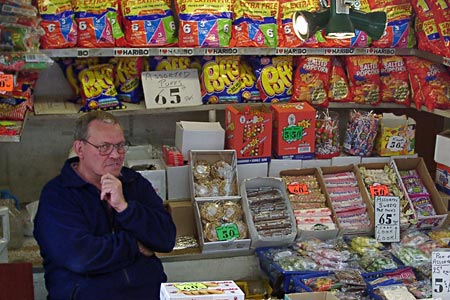Blog
Occasional posts on subjects including field recording, London history and literature, other websites worth looking at, articles in the press, and news of sound-related events.
Sights and sounds of London street markets
HERE ARE SOME photos of London street markets taken about ten years ago, from the same doomed project mentioned in the earlier post on vanished London cafes.
Church Street market is in the Lisson Grove area north of the Marylebone flyover. Ten years ago the market was very much off the tourist trail and catered to the needs of the local community. As with most well-established street markets, an array of unpretentious cafes and pubs co-existed alongside it.
This council workman kindly let me take a picture of him and his waste cart adorned with the furry toys he’d found lying around over the years:

Brick Lane is too deep a subject to summarise easily and needs a post of its own. You’d have been a fool to pay the £55 asking price for one of these guardsman’s tunics without at least trying to haggle. To buy one today from Silverman’s army surplus store in Mile End would set you back £250.

North End Road market runs between Fulham and West Kensington. I remember it in the 1970s as a busy market, with a lot of junk and secondhand shops along there as well. Ten years ago the number of stalls had declined and were limited to one side of the road, as happened with Berwick Street market. This man agreed to let me take a picture of him and his sweet stall, but he doesn’t look overjoyed about it:

A happier face from Whitechapel market, with the stallholder looking at ease in his domain. Most street traders are outgoing and confident people.

Detail from a toy stall in Shepherds Bush market:

Street market sounds are the low-hanging fruit for anyone starting out in field recording. This one from Petticoat Lane market was either the first or second ‘proper’ field recording I made, back in April 2008. I can’t say how happy I was when I got home and played it back, listening to all the different voices, especially that of the man selling batteries (“double A, triple A”):
East Street has a busy market between the Walworth Road and the shifting, uncertain point where it peters out before the Old Kent Road. That day the market had hardly any traders raising their cries, and without persevering it would have been a disappointing visit.
But at the very far end of the market was a single and highly vocal trader, one of perhaps only two or three ‘cheapjacks’ left in London. A fair-sized crowd was captivated by his sales patter:
Unlike vision, hearing can only detect something happening, not that which exists without moving or doing anything. So the simplest strategy for finding interesting sounds is to head where there’s plenty of action, be it the product of people, animals, or the elements.
There’s always something going on at Brick Lane on a Sunday. This recording from 2008 has some strong swearing in it, but it’s meant in a good-humoured way. Not everyone can get away with being that rude – as they say, don’t try it at home:
Some of my earliest memories of London involve markets, such as my mum taking me to Berwick Street where she did her shopping, and that’s surely true for many of us who grew up here. A few years ago I checked the accounts of around a dozen London boroughs to see if they operated their markets at a profit – most of them did.
Of the remainder, Lewisham didn’t calculate profits on its market division, and the council there does a good enough job in supporting its main market in the town centre. A few others had contracted out the running of markets to private firms.
Traditional street markets are still viable concerns well able to sustain themselves, even though almost no effort is put into advertising any of them. Not all councils see them as an asset or a useful service to the public. Westminster Council maintained a vindictive policy for some years towards the tiny market in Pimlico, motivated by personal rows involving a councillor.
Tower Hamlets had a long period of astonishing mismanagement of its markets, and a determined campaign had to be waged in Newham to defend Queen’s Market from the destructive attentions of ‘developers’.
Had the Queen’s Market campaigners lost, and the market struggled in the unfavourable new location planned for it, you can be sure there would have been talk in some quarters of the need to move on, of changing times and expectations, with a sad smile and a shrug of the shoulders, as if describing rain on a bank holiday.
ABOUT SOUND
FIELD RECORDINGS
The balloonist in the desert is dreaming
The Binaural Diaries of Ollie Hall
GEOGRAPHY AND WANDERINGS
The Ragged Society of Antiquarian Ramblers
LONDON
ORGANISATIONS
Midwest Society for Acoustic Ecology
World Forum for Acoustic Ecology